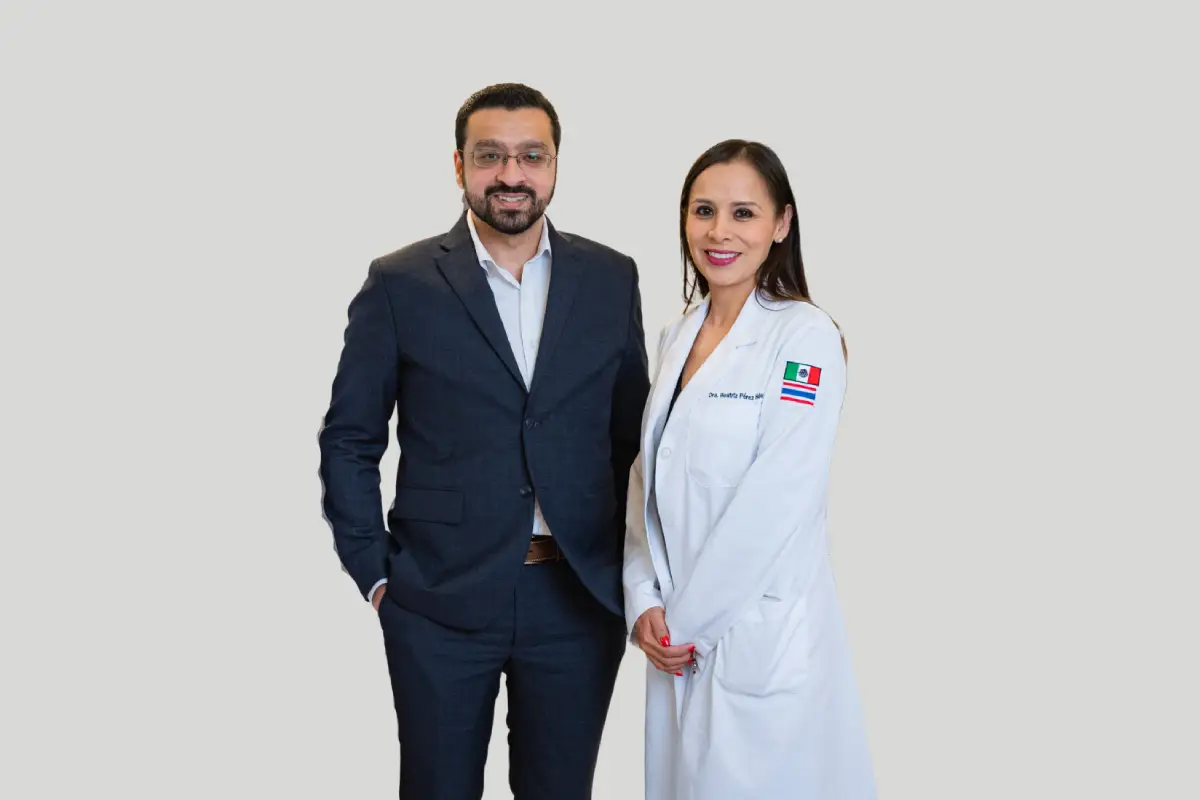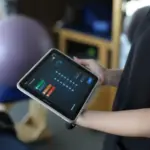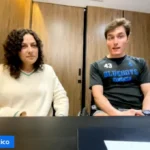In a recent YouTube Live and Facebook Live Q&A session, Verita Neuro’s Medical Directors Dr. Beatriz Perez Hernandez and Dr. Nasir Majeed, joined Chief Growth Officer Hanna Charles to discuss spinal cord injury fundamentals, patient recovery, and the latest treatment options available at Verita Neuro. The session, hosted during Spinal Cord Injury Awareness Month, featured live audience questions and covered key topics like Epidural Stimulation, Stem Cell treatment, rehabilitation, and life after injury, offering insights from Verita Neuro’s extensive clinical experience.
The Fundamentals of Spinal Cord Injuries
What are the most common causes of spinal cord injuries?
Dr. Nasir: Spinal cord injury could result from any insult to the spinal cord, which could be traumatic or it could be non-traumatic. The most common cause of traumatic spinal cord injuries are motor vehicle accidents and falls. Non-traumatic spinal cord injuries could be from spinal stroke or bleeding in the spine.
Dr Beatriz: Non-traumatic causes represent the minority of cases. This could also be from a tumor or an infection, either viral or bacterial. It could also be after a surgery and even it could be related to cancer or other chronic diseases.
Most spinal cord injuries that we treat here at Verita Neuro have traumatic causes. The most common being from motor vehicle accidents, closely followed by falls from high altitudes. Extreme sports, motorcycle accidents and diving are also common.
What is the difference between quadriplegia and paraplegia?
Dr. Nasir: Depending upon the location of the injury it could either affect upper body functions or lower body functions. For some patients with an injury at lower levels of the spine, like the thoracic level or the lumbar level this is called paraplegia which primarily affects the lower limb functions.For some patients where the injury is higher up the spine, around the cervical level, it affects both upper and lower body functions which is called quadriplegia. Although some cervical level injuries only result in paraplegia.
What is the difference between a complete and an incomplete injury?
Dr. Beatriz: We follow the American Spinal Cord Injury Association (ASIA) guidelines, which use the AISA scale to classify the type of injury. This scale is used internationally and divides the assessment of motor and sensory functions. So, we assess not just how much you can move but also how much you can feel.
Motor function is examined through myotomes which are muscle groups controlled by a single spinal nerve. Sensory function is examined through dermatomes, or skin areas supplied by a single spinal nerve) So for each part of the body we assess, we will be able to understand what is happening in specific segments of the spinal cord.
The key factor that differentiates a complete from an incomplete injury is the sacral segments of the spine, specifically S2 to S4. When we apply the AISA scale to a patient, we check for sensation or motor function in those segments. If there is no function there, the injury is classified as complete (AISA A). If some sensation or motor control remains, it becomes an incomplete injury, classified from AISA B through to E. Each with a different prognosis and opportunities for recovery. So, when testing the S2 to S4 sections of the spine, if we find sensation there, the classification changes from AIS A (a complete spinal cord injury) to AISA B (an incomplete injury).
How is spinal cord injury diagnosed and assessed after the initial trauma? How do the first days and hours look?
Dr. Nasir: Primarily, you start with medical history and with an examination. The most important methods to confirm the location and nature of injury are spinal MRI and spinal CT scan. Usually both are done together because both have their own advantages and, together, they give us a complete picture.
Immediately after the trauma, patients are often in a state of medical emergency. Many also suffer from “polytrauma”, which is multiple injuries sustained in the same incident. For example, after a motor vehicle crash the patient may have lip fractures, spleen puncture, lung puncture.
In addition, they often experience “spinal shock”, which is where the spinal cord shuts down and doesn’t function at all immediately after the trauma. So the patient may be on breathing support or on other life support in the first few hours. Usually after 24 hours patients start to come back from the state of shock, or it can last a few days or even weeks. During the first few weeks and months it’s extremely difficult to determine the long-term consequences for a particular patient and it usually takes a few months to conclude the real impact. Also within the first six months many patients may recover a little bit of motor and sensory function without specific treatment. It all depends on how serious the injury is.
Life After Spinal Cord Injuries
What are some of the most common day-to-day challenges that people with spinal cord injuries face?
Dr. Nasir: So usually I think from an outsider’s perspective it appears that the inability to walk is maybe the biggest challenge. But when you actually spend some time with spinal cord injury patients, you can see they actually face very significant challenges which significantly impact their physical and mental health beyond this. For example, blood pressure issues, lack of control over their body temperature. They often have issues controlling the sphincters and lose bladder and bowel functions. They may have serious neuropathic pain. Many of the patients also have spasticity. Then, long-term there are socioeconomic challenges to consider, both for the patient and their families.
How would you say that spinal cord injuries affect mental health? What kind of support is available?
Dr. Beatriz: Being around SCI patients since 2006, I’ve noticed that the biggest impact at the beginning is being unable to walk, and the uncertainty of whether they will ever walk again. The moment this really sinks in is very, very difficult. Misdiagnosis at the beginning can have a negative impact on mental health too, with many patients being told they will never walk again when this isn’t always true. Correct diagnosis and awareness of the injury and prognosis are very, very important to keep the patient moving forward, to stay engaged in rehabilitation, and to achieve the best results possible. It’s also important for their relatives to understand. Sometimes families or patients think that things will get better in one month, and when it doesn’t happen, they feel frustrated. Patients often compare themselves to others too, noticing that another patient is recovering faster or more fully, which can be very discouraging.
As the months go by, not being able to have a conversation face to face with someone but rather looking up right from your wheelchair or from your bed, brings a lot of frustration, anger and depression. It’s very very important to continue the social life to see the friends and see the family and try to live as normally as possible of course with a lot of physio and all of the precautions to be taken.
In our practice we often recommend using medicines to support mental health issues like depression or anxiety. We also recommend psychological support in either individual or group sessions, which can help a lot. I think what is also extremely important is the support of friends and family.
What kind of assistive devices and what kind of technologies are available to help with daily life after a spinal cord injury?
Dr. Beatriz: The availability depends on the country you live in, but worldwide there are many, many technologies that can help you in your everyday life. As simple as “reachers” that, for example, can help you can reach a hanger in your closet, or a glass in the kitchen, or to help you put on socks when you’re dressing. We also have walkers or standing frames which help a lot at home. Sometimes, electrical wheelchairs are useful. At the clinic we usually help patients with e-pacers which is like a walker but helps you support your weight and also helps you to start standing and stepping. There are a wide variety of exoskeletons worldwide, which are great. These really help the patient’s bone, respiratory and gastrointestinal health because you’re in the upright position and this also helps with mental wellbeing. I want to be very clear that all of these devices are not a cure, but they’ll help you to be more independent and to reintegrate socially.
How do spinal cord injury survivors keep their muscle strength post-injury?
Dr. Nasir: Consistent physical therapy and occupational therapy plays a vital role in maintaining overall health and preparing patients for future treatments. Some people lose motivation when told that a full recovery may not be possible and that they will likely remain in a wheelchair. But, even without a complete cure, rehabilitation helps prevent complications like muscle loss, fractures, spasticity, contractures, scoliosis, and impaired blood pressure or temperature regulation. Rehab also provides major psychological benefits. In our day-to-day practice, we notice patients who wake up, prepare for the day, and commit to therapy actually perform better.
We put a strong emphasis on bodyweight training. Standing upright has a positive impact on cardiovascular health, gastrointestinal health, blood circulation, temperature regulation, and can prevent muscle and bone degeneration. We also focus heavily on stretching, as it helps reduce spasticity and maintain flexibility. While there are many types of exercises, consistent bodyweight training and stretching are the most important tools we use to prevent complications.
Common Myths About Spinal Cord Injuries
Recovery from spinal cord injuries comes to halt within the first few months. Myth or fact?
Dr. Beatriz: Traditionally, doctors would tell patients that most recovery happens within the first 12 months. Patients and families often believe that’s the limit. But since I began working with spinal cord injuries in 2006, I have seen that patients can continue to improve after that period. We have seen chronic patients, even five or twenty years after their injury, achieve positive changes through specific protocols. The cornerstone is physical therapy. It remains the most important factor. And now, with new breakthrough treatments, not all improvements are limited to the first year.
Spinal cord injury always results in complete paralysis. Myth or fact?
Dr. Beatriz: Initially, as we mentioned before, there is spinal shock. Once that resolves, we can see what kind of spinal cord injury the patient really has, and whether it is complete or incomplete. This helps us know the prognosis and whether a patient may change from a complete to an incomplete injury, which can happen with time and treatment. Some patients have specific myotomes that are still functioning with normal strength, or at least some ability to move muscles or feel sensation. So not all spinal cord injury patients have complete paralysis.
Spinal cord injuries only affect mobility. Myth or fact?
Dr Nasir: I think this impression forms because everyone can see spinal cord injury patients being in a wheelchair and everyone assumes that this is the most impactful part of their life. Which is of course true but there are other aspects that are very frustrating. Many patients care much more about their loss of bowel and bladder control, than they do about not being able to walk. This, in turn, has a very significant impact on their mental health. It doesn’t feel good to depend on others for this private aspect of their life.
Then, the cardiovascular health suffers. Low blood pressure, being dizzy all the time. This is another very significant impact I would say. When they wake up in the morning they raise their head and they have to wait for a few seconds, or sometimes a few minutes before they can cope with the dizziness, because their blood pressure would suddenly drop. This means it takes a lot of extra time for them to sit upright or move into their wheelchair. So sometimes they are not able to stand simply because they have very low blood pressure, not only because of their muscular impairments.
Also, body temperature regulation. Sometimes they feel very cold, or sometimes they feel very hot because autonomic function is not really functioning.
Then there is neuropathic pain, of course. It can be very devastating. Some patients have very significant neuropathic pain. And while spasticity is a good thing because it helps with recovery, it’s also very uncomfortable and can impact their quality of life.
Another big one is musculoskeletal deformities and fractures. Many patients are prone to fractures. So it’s devastating to have a fracture that is not healing and there is maybe a problem with fusion sometimes.
Innovations in Spinal Cord Injury Treatment
Hanna: Verita Neuro is at the forefront of many innovations in spinal cord injury recovery. I’m very excited to talk about the spinal cord injury treatments that we offer and the hope that still exists for patients. We specialize in advanced options like Epidural Spinal Cord Stimulation, and we are the only center globally to offer it in this form. We also offer LamiSpine surgery, as well as Stem Cell treatments. When patients come to Verita Neuro, they receive a tailored plan that is often a combination of all three treatments, alongside Physical Therapy and Occupational Therapy. All of these options are designed to improve quality of life and, in many cases, restore functions.
Epidural Stimulation: Verita Neuro’s Flagship Treatment
What is Epidural Stimulation and how does it work?
Dr. Beatriz: Epidural Stimulation is one of the most requested treatments by patients. It’s a surgically implanted device designed to amplify the electrical signals in the spinal cord that have been lost due to injury. However, it’s not for everyone and should not always be the first treatment option.
The device works by enhancing the remaining electrical circuits within the spinal cord. During the implantation, we identify combinations of electrodes—or poles—that can best amplify those signals. In this way, we create an “electrical bridge” that helps the patient regain voluntary movement.
Whether the injury is complete or incomplete, the presence of spasms is often a good sign that some signals remain, which we may be able to strengthen through Epidural Stimulation. We also test to confirm whether signals are present and can be successfully amplified through the use of the device.
Who can receive Epidural Stimulation?
Dr. Beatriz: It can be used for both complete and incomplete injuries, but most commonly for complete injuries or AISA B level injuries. In our experience, candidates are typically 12 to 55 years old. Age is not a strict limit if the patient is in good health, continues physical therapy, and has minimal complications.
How do you decide if a patient is a good candidate?
Dr. Beatriz: We perform a personalized evaluation, reviewing medical records and overall health. One key factor is the presence of lower-body spasms, which indicate that some neural connections remain and can be amplified with the stimulator.
How is the stimulator implanted?
Dr. Beatriz: The procedure is performed in an operating room by highly skilled neurosurgeons. A single device implantation takes about two to four hours. The stimulator has 16 leads with positive and negative poles, which allow us to make electrical combinations to restore lost spinal signals. After surgery, patients rest for a few days to prevent the stimulator from moving.
What happens after implantation?
Dr. Beatriz: After surgery, we begin the intensive process of programming and mapping. The 16 leads are adjusted to help the patient achieve voluntary movements. For example, if the goal is hip flexion, we tune the stimulator until the patient can perform it. This is combined with physical therapy to reinforce the movements and improve independence and quality of life.
How long does the treatment take?
Dr. Beatriz: A single Epidural Stimulator requires about 35 consecutive days of therapy. If both cervical and lumbar stimulators are implanted, the program lasts approximately 55 days. This is an intensive process and can be challenging, but it is essential for achieving the best results.
Could you tell us about a patient that you particularly remember who was treated with Epidural Stimulation?
Dr. Beatriz: Sophia Corona. She was involved in a car accident back in January 2018 which resulted in a C5 Cervical level injury, meaning she was quadriplegic. She got the Epidural Stimulator a year after her injury at Verita Neuro in Thailand. She achieved very good results. Right now, Sophia can drive her car, she can use her hands to eat, to do her makeup, and her grooming. She can get dressed and play Jenga. She also stands up, goes swimming and she is able to party or go to social events by herself. She does still need help with stairs and lifting herself. Sophia is very happy to speak with others if you reach out to her on social media.
Another remarkable case was Joao Becker. You can also follow him. He loves people to write to him. He’s a patient from Brazil. He had a T5-T7 spinal cord injury and now he’s a bodybuilder. He walks all the time, stepping with his walking frame.
Then there’s Juan Pablo. He had a T2 level spinal cord injury. He was injured in June 2014 and now he walks independently using his frame every day, for up to an hour and a half. He’s able to go walking from his car to mass, and from his car to an event. I’d like to highlight that not all patients will be able to do this but thoracic patients may achieve this if they’re very, very efficient with their Physical Therapy.
LamiSpine: A Spinal Cord Injury Treatment Designed at Verita Neuro
What is LamiSpine and what are the benefits?
Dr. Nasir: LamiSpine is our proprietary surgical procedure which we developed at Verita Neuro. We perform a small surgery, exposing the spinal cord and removing a small part of the bone from over the level of injury. We then transplant regenerative Stem Cells in the spinal cord in a very, very specific location. We perform the procedure on the border between the healthy and injured tissue where there is still some life left. And we look for the perivascular regions, around the blood vessels. In this area, we also find cytokines, which are proteins which help with the recovery. So this is the regenerative medicine treatment protocol which we have developed. LamiSpine treatment can restore a reasonable level of function even in patients with complete spinal cord injuries.
Hanna: LamiSpine is exclusively available at Verita Neuro and we’ve been offering it for over six years now.
Who can be treated with LamiSpine?
Dr. Nasir: It’s quite an aggressive form of treatment so not everyone is a candidate. It also comes with some potential side effects. So we are very careful in selecting who could qualify for this kind of treatment. Occasionally we combine LamiSpine with Epidural Stimulation but we usually only recommend one or the other.
What happens after the LamiSpine surgery?
Dr. Nasir: After LamiSpine we have a very specific rehab protocol where we do a lot of external electrical stimulation, which is still a very important part of our day-to-day work outside of Epidural Stimulation. So, we use electrical stimulation, electromagnetic stimulation, extensive Physical Therapy and locomotive training.
Stem Cell Treatment: Verita Neuro’s Regenerative Medicine Protocol
What are the benefits of Stem Cell treatment?
Dr. Beatriz: Stem Cells are an especially good option for acute cases, by which I mean patients in the first one to two years after injury. Stem Cells have three specific characteristics: they are anti-inflammatory, regenerative and they regulate the immune system. So that helps a lot during the acute phase. We combine Stem Cells with Physical Therapy, like pelvic floor exercises.
Verita Neuro has been invited many times to present our cases because we have achieved very, very good results. In acute patients, 95% have regained autonomic functions, like control of the bladder, bowel and sexual functions. This is a big change for patients and their relatives, as these complications can be very demoralizing. So when we can help patients stop wearing diapers or having accidents in public, this is a great result.
Where do Verita Neuro obtain their Stem Cells?
Dr. Beatriz: Our Stem Cells are cultivated in the laboratories and they don’t have genetic information. So there is no limitation on which Stem Cells can be used for each patient. It means there are no harmful genetic mutations in the Cells either because we have controlled for that.
Are there any side effects of using Stem Cell treatment?
Dr. Beatriz: Right after the treatment is administered, patients may develop a headache or become a little bit sleepy. They may also have pain at the lumbar puncture site, where we inject the Stem Cells.
Can you tell us about a patient you successfully treated with Stem Cells?
Dr. Beatriz: We had a 17-year-old patient named Leo who suffered a spinal cord injury while surfing. It took around 18 hours to bring him to Guadalajara because he was at a remote beach. He was told what many patients hear: that he would probably never walk again.
His parents immediately began researching new treatments and found Verita Neuro. We evaluated him about 10 days after the injury, following his surgery. Just 12 days post-injury, he began a 35-day acute program with Stem Cells.
By the end of the program, he was able to walk with a walker and had regained voluntary control of his bladder, bowel, and sexual functions, as well as full sensation.
Over the next two years, he received three more Stem Cell treatments. Today, he’s in college, drives, walks independently, and controls all functions. He barely remembers what living with a spinal cord injury was like. He was very fortunate to begin treatment in the acute phase.
Can Stem Cell treatment be used for patients after the acute phase, two or more years on from their injury?
Dr. Beatriz: Yes, absolutely. I remember a patient who was 10 years post–spinal cord injury. After treatment, she regained autonomic and pelvic floor functions and was very happy to also recover some sensation in her legs. We even saw her functional level improve by five segments, from T5 to T12. Meaning she regained additional movement and sensation. So, stem cells are a good option for both acute and chronic patients. Of course, we always do a thorough evaluation first, but the results can be very positive.
The above is not a verbatim transcript of the Doctor’s live discussion. Some comments have been altered or rearranged to improve the reading flow. You can watch the full live on our YouTube channel.





